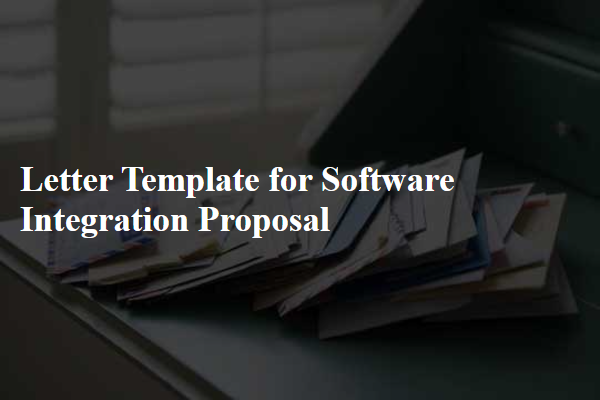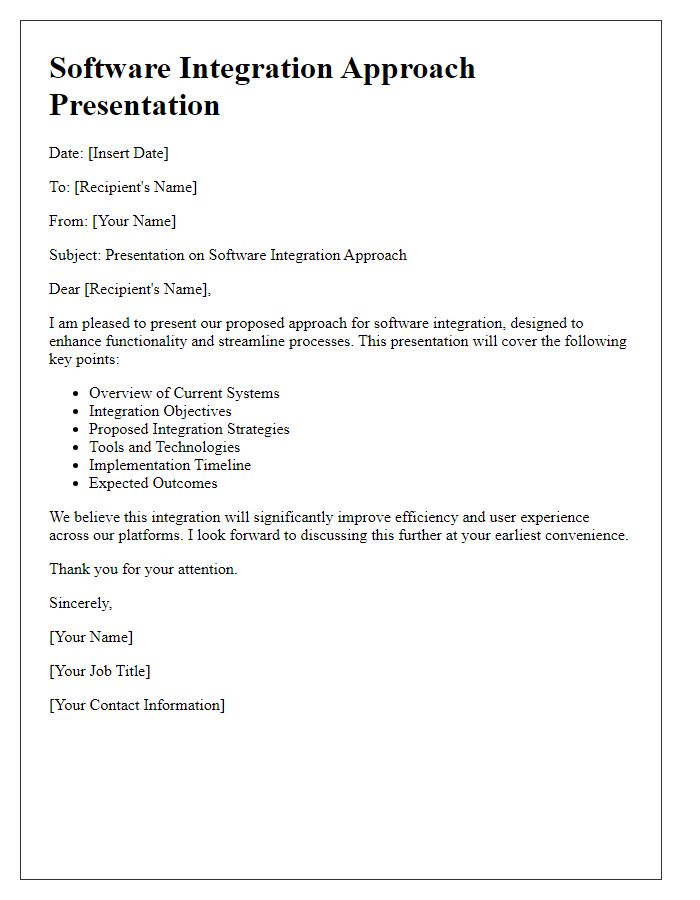Are you looking to streamline your business processes and enhance productivity through software integration? In today's fast-paced tech environment, seamless connectivity between various systems is crucial for success. Our proposal outlines innovative solutions that can help your organization eliminate redundancies and improve overall performance. Dive into the details and discover how we can transform your workflowsâread more to explore this exciting opportunity!

Project Overview
The software integration project aims to streamline processes within the organization by unifying disparate systems, such as Customer Relationship Management (CRM) software like Salesforce, Enterprise Resource Planning (ERP) systems like SAP, and other essential platforms. Integration seeks to enhance data flow, improve user experience, and foster collaboration across departments, particularly in Finance, Marketing, and Sales. Critical metrics for success include reducing data entry errors by 30%, decreasing operational costs by up to 25%, and increasing productivity through automation features. The target timeline for completion spans six months, with initial phases focusing on needs assessment and system architecture design, ensuring robust compatibility and security measures throughout the integration process.
Technical Requirements
A comprehensive software integration proposal outlines essential technical requirements to ensure seamless interoperability between systems such as enterprise resource planning (ERP) platforms and customer relationship management (CRM) tools. Key requirements include the application programming interface (API) specifications, which dictate how different software components communicate, typically requiring RESTful or SOAP protocols. Data formats such as XML or JSON must be identified for smooth data exchange between systems. Security measures, including encryption standards like Advanced Encryption Standard (AES) and secure socket layer (SSL) protocols, are paramount to safeguard sensitive information during transmission. Additionally, compatibility with cloud services such as Amazon Web Services (AWS) or Microsoft Azure must be considered for scalability and reliability. The timeline for integration phases should also specify milestones, with testing schedules for functionality, performance, and user acceptance to validate the integration's success in a live environment.
Implementation Timeline
The implementation timeline for software integration projects typically spans several phases, each involving specific tasks and milestones. Initial phase, often lasting 2-4 weeks, focuses on requirements gathering, where stakeholders collaborate to define objectives and functionality. The development phase, which can take 3-6 months, includes coding, testing, and refinement of the integration solution, ensuring compatibility across platforms such as ERP systems or CRM applications. Following development, a pilot phase usually lasts 1-2 months, where the integration is tested in a controlled environment to identify any issues. Finally, the deployment phase spans 1-3 weeks, involving rollout to the production environment and training for end-users, with ongoing support and maintenance slated for the following months to address any post-implementation challenges and optimize performance.
Cost Estimates
In software integration projects, accurate cost estimates are crucial for budget planning and resource allocation. Key factors that impact costs include software licensing fees, with options ranging from $500 to $10,000 depending on the software's complexity and vendor. Additionally, development labor costs in regions such as North America, where hourly rates can reach $150, contrast significantly with $40 per hour in Eastern Europe. Integration tools such as APIs, which can incur costs from $50 to $500 monthly, need to be considered. Testing environments, essential for quality assurance, can add another layer of expenses; cloud solutions may charge between $100 to $1,000 monthly depending on usage. Lastly, ongoing maintenance and support must be projected, as this can account for 15-20% of the initial integration cost annually. Understanding these financial components equips stakeholders with a clear overview of the investment needed for a successful software integration initiative.
Support and Maintenance
The proposal for software integration emphasizes the importance of ongoing support and maintenance to ensure optimal performance and adaptability of the integrated solutions. Continuous software updates are vital for cybersecurity, protecting against emerging threats and vulnerabilities identified in software systems. Scheduled maintenance, including troubleshooting and performance optimization, is essential for minimizing downtime and enhancing user experience across various platforms, such as Windows, macOS, and Linux. Furthermore, dedicated support teams, available 24/7, resolve issues rapidly, underscoring a commitment to seamless operations for businesses relying on integrated software solutions. This structured support framework assures that organizations can focus on core activities while maintaining robust, efficient technology systems.













Comments